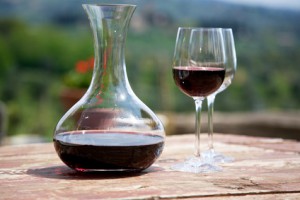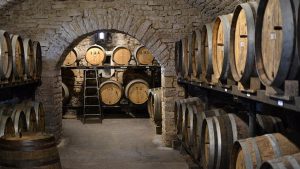To decant or not to decant – that is the often controversial question. While some wine lovers tend to decant almost systematically, others see this as a serious crime. So what is the best way to prepare your wine before serving?
Years ago in a time of “high society” dinners, it was customary to decant wine… not so much to aerate it and develop the aromas, but to avoid giving the impression that someone is “flashing” a prestigious label. In those days, discretion was seen as an important sign of education…
Thankfully the use of a decanter is now seen as a technical gesture, with the aim to improve a wine, and not just part of social code. But will its use really improve a wine?
Firstly, keep in mind that decanting can be quite a shock to a wine. The reaction is very sudden and the wine goes from being almost completely oxygen free, to receiving maximum aeration. For this reason, it is not advised to decant fragile wines, for example those of an advanced age.
Conversely, decanting might be considered for very young red wines. Rapid aeration allows the wine to slightly “relax” and dispels potential reductive flavours. While aeration will also gradually take place when wine is poured into a glass or if the bottle is half full, a decanter will accelerate this process.
However, you should always be cautious: some varieties need to be handled with more care (for example Grenache and Pinot Noir), while a young Bordeaux or northern Rhône (Syrah) wine is more suited to this “violent” process.
Important factors to consider:
– When in doubt and if you don’t know a wine’s characteristics, it is better to abstain from decanting. Rapid aeration (through decanting) could be catastrophic, with no turning back, while a lack of ventilation will simply correct itself in the glass or open bottle.
– The least risky and most effective method is to open a bottle in advance (at least two hours, but sometimes even more) and pour a little into a glass, leaving the bottle’s level below its shoulder. You can always replace the missing glassful before serving, if it hasn’t “disappeared” yet…
– Another option is to pour some wine in a glass and observe its evolution over 20 minutes. If the wine doesn’t change after this period, its flavours are more reserved and there will be no risk when using a decanter. However, if you feel that the flavours develop within minutes, then don’t decant!
– Decanting a very old wine involves an often complicated ritual – an action of very slowly pouring wine into a decanter, leaving the sediment in the bottle. From experience, however, it is extremely dangerous to decant an old wine. The rapid oxygenation after decades spent in a virtually airtight container can be disastrous! Worst comes to worst, it will accelerate ageing and turn the wine into a nearly undrinkable beverage in less than 20 minutes…
It is therefore better to stick to the method of slow oxygenation for old wines. Store the bottle in a vertical position for two days prior to serving. This allows the sediment to settle on the bottom, so you can carefully serve the wine from the bottle without stirring up the sediment. Obviously, when it is a very structured (tannic) wine from a great vintage, this guideline can be ignored and decanting could be considered.
– Unexpectedly, young, fruity white wines with little or no wood will often benefit most from decanting. Aeration tends to develop their primary fruity aromas, making them more enjoyable.
– Finally, if you want to decant a bottle for technical reasons, but you still want to show off the bottle and label – to a friend who might comment that the wine is “not bad for a little Burgundy”, while it is actually a 100 pointer Pontet-Canet 2009 – then simply pour the wine back into the bottle (with a funnel) after it spent an hour in a decanter.
As always, when it comes to wine tasting, it is your own personal experiences that will guide you the best. Share your tips with us!
Visit iDealwine.com




